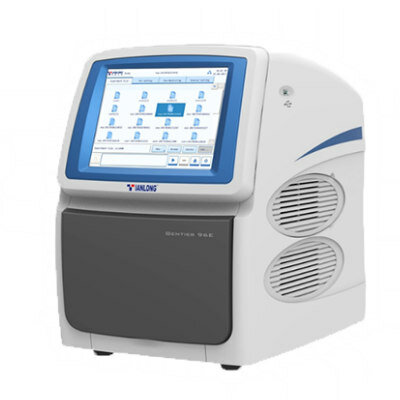Coagulation Dysfunction and Infection Evaluated in Patients with AECOPD
|
By LabMedica International staff writers Posted on 14 Apr 2021 |

Image: Histology comparison of airway features in (A) a healthy individual and (B) in a patient with chronic obstructive pulmonary disease where airways are narrowed by infiltration of inflammatory cells, mucosal hyperplasia, and deposition of connective tissue in the peribronchiolar space (Photo courtesy of University of Leuven)
Chronic obstructive pulmonary disease (COPD) is one of the common chronic airway obstructive diseases, characterized by persistent respiratory symptoms and airflow limitation. In acute exacerbation stage (AECOPD), patients developed respiratory failure often have circulatory and coagulation dysfunction, which was considered the cause of thrombosis events in the patients.
Although the inflammation in the early stage of COPD only involves the trachea and lung, hypoxia and further acute inflammation are systemic. In acute exacerbation stage, patients developed respiratory failure often have circulatory and coagulation dysfunction, which was considered the cause of thrombosis events in the patients. The coagulation abnormality could cause pulmonary embolism, myocardial infarction, cerebral infarction, and other thrombosis events in COPD patients.
Respiratory and Critical Care Medicine Scientists from the Anhui Medical University (Hefei, China) performed a retrospective clinical study to investigate the factors correlated to abnormal coagulation status in COPD from November 2016 to November 2019. A total of 135 AECOPD, 44 stable stage COPD patients, and 135 healthy controls were enrolled in this study. The coagulation parameters, blood gas indexes and blood routine examination results were collected and analyzed.
The scientists reported that white blood count (WBC), neutrophil count, neutrophil percentage (N%), platelet (PLT), prothrombin time (PT), international normalized ratio (INR), fibrinogen (FIB), and activated partial thromboplastin time (APTT) increased, plasma thrombin time (TT) decreased in AECOPD group compared with the control group. In AECOPD group, PT, APTT, and FIB were positively correlated with neutrophils and C‐reaction protein levels. PT was positively correlated with partial pressure of carbon dioxide (PCO2) and negatively with pH. Thrombosis was observed in five acute exacerbation and three stable stage COPD patients. In 38 patients with abnormal blood gas analysis indexes, PT level was negatively correlated with pH, positively correlated with arterial partial pressure of carbon dioxide (PaCO2) levels indicating abnormal coagulation status was correlated to hypercapnia and acidosis.
The authors concluded that their study revealed that coagulation dysfunction existed in AECOPD patients. The abnormal coagulation was correlated to infection and hypercapnia and might be the main cause of thrombosis in the patients. The study was published on March 25, 2021 in the Journal of Clinical Laboratory Analysis.
Related Links:
Anhui Medical University
Although the inflammation in the early stage of COPD only involves the trachea and lung, hypoxia and further acute inflammation are systemic. In acute exacerbation stage, patients developed respiratory failure often have circulatory and coagulation dysfunction, which was considered the cause of thrombosis events in the patients. The coagulation abnormality could cause pulmonary embolism, myocardial infarction, cerebral infarction, and other thrombosis events in COPD patients.
Respiratory and Critical Care Medicine Scientists from the Anhui Medical University (Hefei, China) performed a retrospective clinical study to investigate the factors correlated to abnormal coagulation status in COPD from November 2016 to November 2019. A total of 135 AECOPD, 44 stable stage COPD patients, and 135 healthy controls were enrolled in this study. The coagulation parameters, blood gas indexes and blood routine examination results were collected and analyzed.
The scientists reported that white blood count (WBC), neutrophil count, neutrophil percentage (N%), platelet (PLT), prothrombin time (PT), international normalized ratio (INR), fibrinogen (FIB), and activated partial thromboplastin time (APTT) increased, plasma thrombin time (TT) decreased in AECOPD group compared with the control group. In AECOPD group, PT, APTT, and FIB were positively correlated with neutrophils and C‐reaction protein levels. PT was positively correlated with partial pressure of carbon dioxide (PCO2) and negatively with pH. Thrombosis was observed in five acute exacerbation and three stable stage COPD patients. In 38 patients with abnormal blood gas analysis indexes, PT level was negatively correlated with pH, positively correlated with arterial partial pressure of carbon dioxide (PaCO2) levels indicating abnormal coagulation status was correlated to hypercapnia and acidosis.
The authors concluded that their study revealed that coagulation dysfunction existed in AECOPD patients. The abnormal coagulation was correlated to infection and hypercapnia and might be the main cause of thrombosis in the patients. The study was published on March 25, 2021 in the Journal of Clinical Laboratory Analysis.
Related Links:
Anhui Medical University
Latest Clinical Chem. News
- 3D Printed Point-Of-Care Mass Spectrometer Outperforms State-Of-The-Art Models
- POC Biomedical Test Spins Water Droplet Using Sound Waves for Cancer Detection
- Highly Reliable Cell-Based Assay Enables Accurate Diagnosis of Endocrine Diseases
- New Blood Testing Method Detects Potent Opioids in Under Three Minutes
- Wireless Hepatitis B Test Kit Completes Screening and Data Collection in One Step
- Pain-Free, Low-Cost, Sensitive, Radiation-Free Device Detects Breast Cancer in Urine
- Spit Test Detects Breast Cancer in Five Seconds
- Electrochemical Sensors with Next-Generation Coating Advances Precision Diagnostics at POC
- First-Of-Its-Kind Handheld Device Accurately Detects Fentanyl in Urine within Seconds
- New Fluorescent Sensor Array Lights up Alzheimer’s-Related Proteins for Earlier Detection
- Automated Mass Spectrometry-Based Clinical Analyzer Could Transform Lab Testing
- Highly Sensitive pH Sensor to Aid Detection of Cancers and Vector-Borne Viruses
- Non-Invasive Sensor Monitors Changes in Saliva Compositions to Rapidly Diagnose Diabetes
- Breakthrough Immunoassays to Aid in Risk Assessment of Preeclampsia
- Urine Test for Monitoring Changes in Kidney Health Markers Can Predict New-Onset Heart Failure
- AACC Releases Comprehensive Diabetes Testing Guidelines
Channels
Clinical Chemistry
view channel
3D Printed Point-Of-Care Mass Spectrometer Outperforms State-Of-The-Art Models
Mass spectrometry is a precise technique for identifying the chemical components of a sample and has significant potential for monitoring chronic illness health states, such as measuring hormone levels... Read more.jpg)
POC Biomedical Test Spins Water Droplet Using Sound Waves for Cancer Detection
Exosomes, tiny cellular bioparticles carrying a specific set of proteins, lipids, and genetic materials, play a crucial role in cell communication and hold promise for non-invasive diagnostics.... Read more
Highly Reliable Cell-Based Assay Enables Accurate Diagnosis of Endocrine Diseases
The conventional methods for measuring free cortisol, the body's stress hormone, from blood or saliva are quite demanding and require sample processing. The most common method, therefore, involves collecting... Read moreMolecular Diagnostics
view channel
Unique Autoantibody Signature to Help Diagnose Multiple Sclerosis Years before Symptom Onset
Autoimmune diseases such as multiple sclerosis (MS) are thought to occur partly due to unusual immune responses to common infections. Early MS symptoms, including dizziness, spasms, and fatigue, often... Read more
Blood Test Could Detect HPV-Associated Cancers 10 Years before Clinical Diagnosis
Human papilloma virus (HPV) is known to cause various cancers, including those of the genitals, anus, mouth, throat, and cervix. HPV-associated oropharyngeal cancer (HPV+OPSCC) is the most common HPV-associated... Read moreImmunology
view channel
Diagnostic Blood Test for Cellular Rejection after Organ Transplant Could Replace Surgical Biopsies
Transplanted organs constantly face the risk of being rejected by the recipient's immune system which differentiates self from non-self using T cells and B cells. T cells are commonly associated with acute... Read more
AI Tool Precisely Matches Cancer Drugs to Patients Using Information from Each Tumor Cell
Current strategies for matching cancer patients with specific treatments often depend on bulk sequencing of tumor DNA and RNA, which provides an average profile from all cells within a tumor sample.... Read more
Genetic Testing Combined With Personalized Drug Screening On Tumor Samples to Revolutionize Cancer Treatment
Cancer treatment typically adheres to a standard of care—established, statistically validated regimens that are effective for the majority of patients. However, the disease’s inherent variability means... Read moreMicrobiology
view channel
Mouth Bacteria Test Could Predict Colon Cancer Progression
Colon cancer, a relatively common but challenging disease to diagnose, requires confirmation through a colonoscopy or surgery. Recently, there has been a worrying increase in colon cancer rates among younger... Read more.jpg)
Unique Metabolic Signature Could Enable Sepsis Diagnosis within One Hour of Blood Collection
Sepsis is a life-threatening condition triggered by an extreme response of the body to an infection. It requires immediate medical intervention to prevent potential death or lasting damage.... Read morePathology
view channel
Spatial Tissue Analysis Identifies Patterns Associated With Ovarian Cancer Relapse
High-grade serous ovarian carcinoma is the most lethal type of ovarian cancer, and it poses significant detection challenges. Typically, patients initially respond to surgery and chemotherapy, but the... Read more.jpg)
Unique Hand-Warming Technology Supports High-Quality Fingertip Blood Sample Collection
Warming the hand is an effective way to facilitate blood collection from a fingertip, yet off-the-shelf solutions often do not fulfill laboratory requirements. Now, a unique hand-warming technology has... Read moreTechnology
view channel
New Diagnostic System Achieves PCR Testing Accuracy
While PCR tests are the gold standard of accuracy for virology testing, they come with limitations such as complexity, the need for skilled lab operators, and longer result times. They also require complex... Read more
DNA Biosensor Enables Early Diagnosis of Cervical Cancer
Molybdenum disulfide (MoS2), recognized for its potential to form two-dimensional nanosheets like graphene, is a material that's increasingly catching the eye of the scientific community.... Read more
Self-Heating Microfluidic Devices Can Detect Diseases in Tiny Blood or Fluid Samples
Microfluidics, which are miniature devices that control the flow of liquids and facilitate chemical reactions, play a key role in disease detection from small samples of blood or other fluids.... Read more
Breakthrough in Diagnostic Technology Could Make On-The-Spot Testing Widely Accessible
Home testing gained significant importance during the COVID-19 pandemic, yet the availability of rapid tests is limited, and most of them can only drive one liquid across the strip, leading to continued... Read moreIndustry
view channel
ECCMID Congress Name Changes to ESCMID Global
Over the last few years, the European Society of Clinical Microbiology and Infectious Diseases (ESCMID, Basel, Switzerland) has evolved remarkably. The society is now stronger and broader than ever before... Read more
Bosch and Randox Partner to Make Strategic Investment in Vivalytic Analysis Platform
Given the presence of so many diseases, determining whether a patient is presenting the symptoms of a simple cold, the flu, or something as severe as life-threatening meningitis is usually only possible... Read more
Siemens to Close Fast Track Diagnostics Business
Siemens Healthineers (Erlangen, Germany) has announced its intention to close its Fast Track Diagnostics unit, a small collection of polymerase chain reaction (PCR) testing products that is part of the... Read more

















